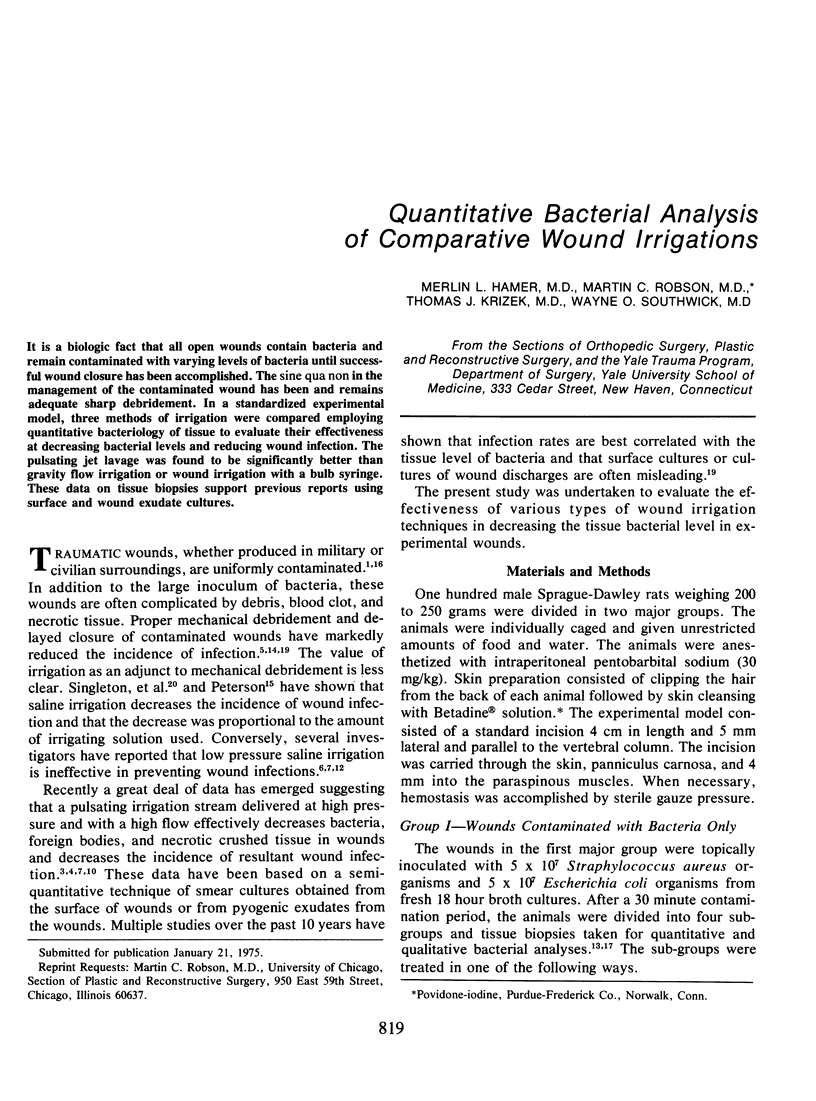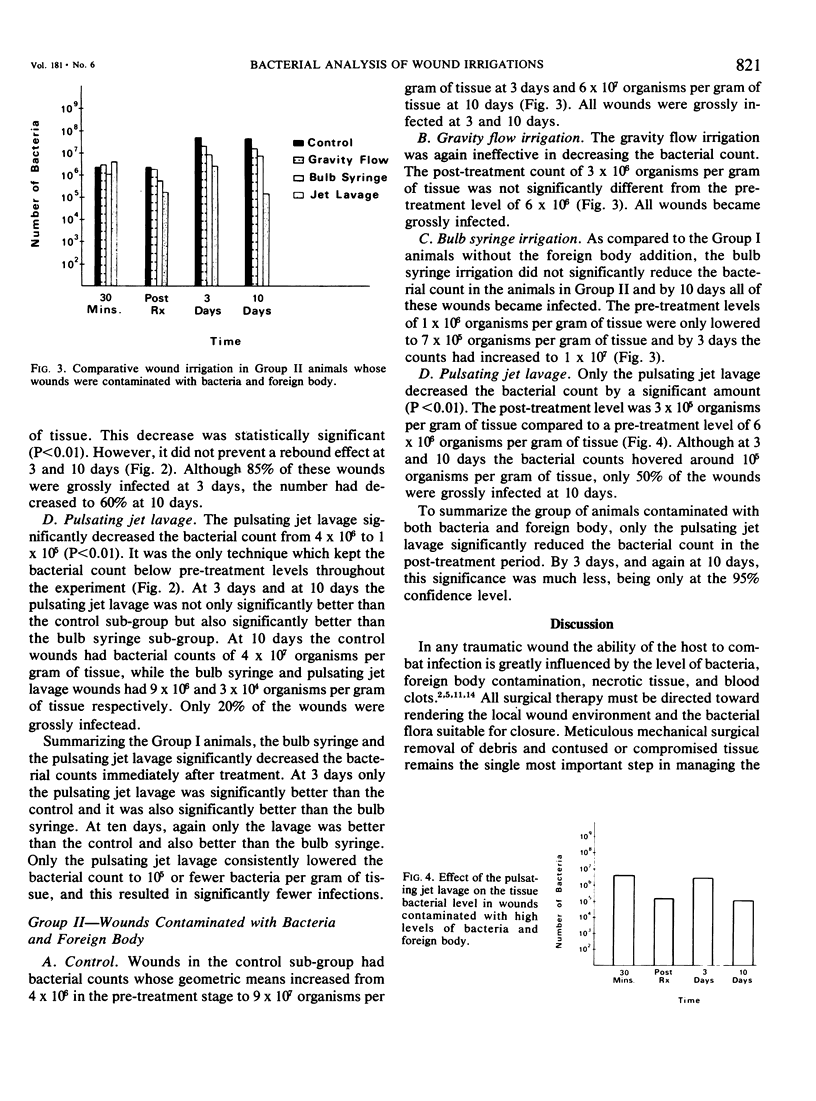Abstract
It is a biologic fact that all open wounds contain bacteria and remain contaminated with varying levels of bacteria until successful wound closure has been accomplished. The sine qua non in the management of the contaminated wound has been and remains adequate sharp debridement. In a standardized experimental model, three methods of irrigation were compared employing quantitative bacteriology of tissue to evaluate their effectiveness at decreasing bacterial levels and reducing wound infection. The pulsating jet lavate was found to be significantly better than gravity flow irrigation or wound irrigation with a bulb syringe. These data on tissue biopsies support previous reports using surface and wound exudate cultures.
Full text
PDF



Selected References
These references are in PubMed. This may not be the complete list of references from this article.
- Bhaskar S. N., Cutright D. E., Gross A. Effect of water lavage on infected wounds in the rat. J Periodontol. 1969 Nov;40(11):671–672. doi: 10.1902/jop.1969.40.11.671. [DOI] [PubMed] [Google Scholar]
- Bhaskar S. N., Cutright D. E., Gross A., Frisch J., Beasley J. D., 3rd, Perez B. Water jet devices in dental practice. J Periodontol. 1971 Oct;42(10):658–664. doi: 10.1902/jop.1971.42.10.658. [DOI] [PubMed] [Google Scholar]
- Churchill E. D. The Surgical Management of the Wounded in the Mediterranean Theater at the Time of the Fall of Rome-[Foreword by Brig. Gen'l Fred W. Rankin, M.C.]. Ann Surg. 1944 Sep;120(3):268–283. doi: 10.1097/00000658-194409000-00002. [DOI] [PMC free article] [PubMed] [Google Scholar]
- Edlich R. F., Custer J., Madden J., Dajani A. S., Rogers W., Wangensteen O. H. Studies in management of the contaminated wound. 3. Assessment of the effectiveness of irrigation with antiseptic agents. Am J Surg. 1969 Jul;118(1):21–30. doi: 10.1016/0002-9610(69)90089-0. [DOI] [PubMed] [Google Scholar]
- Gross A., Bhaskar S. N., Cutright D. E., Beasley J. D., 3rd, Perez B. The effect of pulsating water jet lavage on experimental contaminated wounds. J Oral Surg. 1971 Mar;29(3):187–190. [PubMed] [Google Scholar]
- Gross A., Cutright D. E., Bhaskar S. N. Effectiveness of pulsating water jet lavage in treatment of contaminated crushed wounds. Am J Surg. 1972 Sep;124(3):373–377. doi: 10.1016/0002-9610(72)90044-x. [DOI] [PubMed] [Google Scholar]
- Grower M. F., Bhaskar S. N., Horan M. J., Cutright D. E. Effect of water lavage on removal of tissue fragments from crush wounds. Oral Surg Oral Med Oral Pathol. 1972 Jun;33(6):1031–1036. doi: 10.1016/0030-4220(72)90197-1. [DOI] [PubMed] [Google Scholar]
- HAMPTON O. P., Jr FUNDAMENTALS OF SURGERY OF SEPTIC WOUNDS. Ann Surg. 1963 Nov;158:864–871. doi: 10.1097/00000658-196311000-00015. [DOI] [PMC free article] [PubMed] [Google Scholar]
- Hopson W. B., Jr, Britt L., Sherman R. T., Ledes C. P. The use of topical antibiotics in the prevention of experimental wound infection. J Surg Res. 1968 Jun;8(6):261–266. doi: 10.1016/0022-4804(68)90096-6. [DOI] [PubMed] [Google Scholar]
- KRIZEK T. J., DAVIS J. H. THE ROLE OF THE RED CELL IN SUBCUTANEOUS INFECTION. J Trauma. 1965 Jan;5:85–95. doi: 10.1097/00005373-196501000-00009. [DOI] [PubMed] [Google Scholar]
- LOWRY K. F., CURTIS G. M. Pertinent factors influencing repair in traumatic wounds. Am J Surg. 1949 Nov;78(5):781–792. doi: 10.1016/0002-9610(49)90320-7. [DOI] [PubMed] [Google Scholar]
- Robson M. C., Heggers J. P. Surgical infection. I. Single bacterial species or polymicrobic in origin? Surgery. 1969 Apr;65(4):608–610. [PubMed] [Google Scholar]
- SINGLETON A. O., Jr, DAVIS D., JULIAN J. The prevention of wound injection following contamination with colon organisms. Surg Gynecol Obstet. 1959 Apr;108(4):389–392. [PubMed] [Google Scholar]


